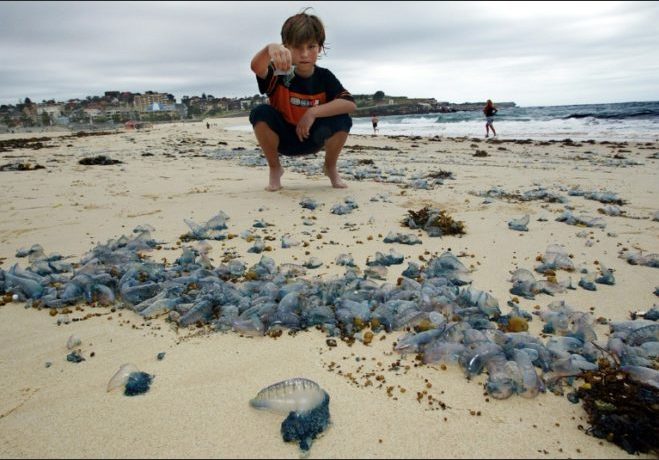
Bluebottle invasion sees thousands of Queensland beachgoers stung in a day
A bluebottle jellyfish invasion has seen thousands of beachgoers stung by the creatures in southeast Queensland over the weekend.
More than 2630 people, including children, have been treated for stings since Saturday on the Gold and Sunshine coasts in the state's southeast, as the jellyfish swarm beaches in record numbers.
Almost 1000 people were hurt in a matter of hours on Sunday afternoon, with 476 bluebottle stings treated on the Gold Coast and 461 on the Sunshine Coast. Several of those stung suffered anaphylactic shock.
On Saturday, 1323 people were stung on the Gold Coast alone. And some 13,000 stings have been treated by paramedics in the region over the past week.
Surf Life Saving duty officer Jeremy Sturges said it was an "epidemic".
"I have never seen anything like this - ever," Mr Sturges said.
"Not everyone reacts the same way but there have been very serious reactions."Unusually strong northeasterly swell conditions pushed the bluebottles onshore and they are clumped in their thousands along the shoreline. Lifesavers have been forced to close several beaches.
Mr Sturges warned it was not just swimmers at risk with the jellyfish stranded along the tide lines still very much alive.
"People have been hurt as they just walk along the shoreline. Don't pick it up, don't walk on it or you will be stung."
Surf Life Saving Queensland issued a "major bluebottle warning" and a spokesperson said that
if stung, remove stingers, take a very hot shower and apply ice.Queensland Ambulance also provided advice for anyone stung by a bluebottle jellyfish.
"They're back," the service's Twitter post read.
"If you're stung by a bluebottle try and pick off the tentacles with a towel or other object, rinse the area with seawater, place the affected area in warm water and, if needed, apply ice packs.
Avoid using vinegar if it's clearly a bluebottle sting."Australian Marine Stinger Advisory Service director Lisa-Ann Gershwin told the ABC the striking blue jellyfish lived in armadas in the middle of the ocean and had a keel-like crest and trailing tentacles.
"Bluebottles have definitely been fairly rambunctious lately, pretty much throughout southeast Queensland, they've been coming in large numbers in a lot of places," Dr Gershwin told the public broadcaster.
"They are also appearing at beaches in New South Wales, Victoria and Tassie - we've been getting them in a lot of places."
Dr Gershwin said a bluebottle's crest acted like a sail and they were pushed along by strong winds.
"They get picked up by the wind and blown as long as the wind keeps going or until they hit land and strand on the beaches, so that's when we see them obviously," she said.
"It's nature's way of making sure the population never becomes extinct."

Comment: Over 3,000 people have been stung by jellyfish on Florida beaches in the past two weeks